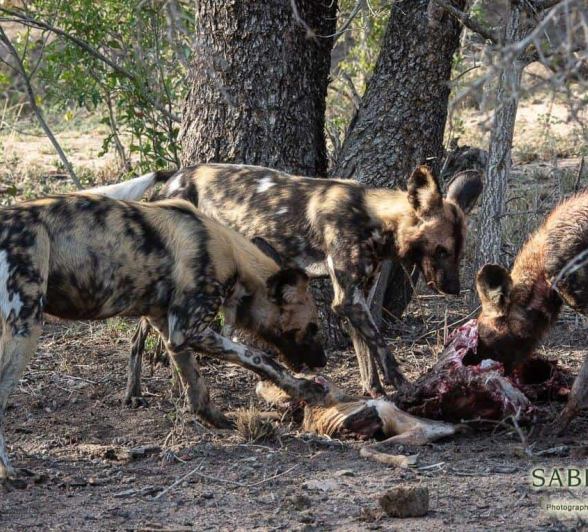Understanding carnivores
on Apr 30, 2019Too often we hear how predators are cruel and calculating; and how all animals should be herbivores. The idea of animals hunting either excites or horrifies – both are fair reactions. Ultimately, predators bring balance to our ecosystem – they add diversity and help control numbers of certain species. When carnivores hunt, they are not being evil but are doing what comes naturally and depending on their anatomy, every species has their own way of hunting.
Take Wild Dogs/Painted Wolves for example – they are probably some of the most successful hunters to exist. With their slender build and long legs, they are endurance hunters with phenomenal stamina and whilst their hunting method may seem cruel to many, there is a reason they run their prey almost to exhaustion – unlike Lions or Leopards who do not have sharp, retractable claws meaning they are unable to grasp their prey without it escaping. When their prey can no longer continue, the Wild Dogs will quickly catch up and start consuming their victim. I am human and watching this is never an easy sighting, but it is a highly successful strategy which has about an 80% chance of working.


Leopards on the other hand, rely more on stealth and strength. Once they have spotted potential prey, they almost immediately snap into hunting mode. The feline will crouch low observing the scene, they take wind direction into account as well as obstacles (bushes/termite mounds/boulders etc.) which they could use to best conceal themselves as they move closer. Leopards have exceptional eyesight and can spot small prey species from many many meters away. They need to be careful not to make any sound so its hind foot lands precisely where the forefoot leaves. If spotted, their prey (Impala/Kudu/Nyala etc.) will give a loud alarm call, thus foiling their efforts making it nearly impossible to carry on. Once the Leopard has patiently stalked its prey, it will ambush the animal from a short distance away, grabbing hold of it and often crushing the trachea with sharp teeth to suffocate they prey. A hunt usually takes time and effort. The kill, which can sometimes weigh the same as Leopard, is then hoisted into a tree.




Like Leopards, Lions also put a lot of time, thought and effort in when hunting. One can imagine how much power and care it must take to successfully take down a large Cape Buffalo. Lions hunt as a group and often every individual in the hunting party will do its bit, working as a team they will be able to secure themselves a meal but are not always successful. A large mammal such as a Cape Buffalo can feed a pride of Lions for at least 2-3 days (depending on the pride/coalition size). It is also not over after the hunt; they would still need to defend their well-earned meal from being stolen by lurking scavengers such as Spotted Hyenas.




Cheetahs have a slightly different strategy and rely largely on speed after having scanned the vast, unobstructed open plains for species such as Common Duiker or Impala. They only have semi-retractable claws which help add traction when running/hunting. A Cheetah has long legs, narrow hips, a long tail (used for balance and directing animal) and a large thoracic cavity to maximize lung capacity. Although Cheetahs are our fastest land mammal, they are able to reach speeds of up to 100km/h only for short distances and need to rest and cool down quickly after a hunt. They also need to consume as much of their kill as quickly as possible as they are very vulnerable to having their meal stolen by a variety of predators including Lion, Leopard and Spotted Hyenas. Cheetahs rely heavily on being in good condition so they can successfully run and hunt and cannot afford risking injury defending their meal.



The last predator which often gets a bad reputation – the Spotted Hyena. I frequently hear/read people mention how they dislike these animals and find them ‘mean’. Amusingly, I think The Lion King may have a lot to do with this. Yes, Spotted Hyenas can appear as dodgy characters in the bush, often lurking around lodges, visiting drink stops or trailing predators all the while in search of an easy meal, but these carnivores are perfectly capable of killing their own prey. Hyenas are incredibly powerful creatures, often being much larger than people expect. Spotted Hyenas did not get sharp claws or speed, they simply received hugely powerful jaws and brute strength. Whilst smaller prey may be taken by an individual, larger prey such as Kudu, young Giraffe and Wildebeest can be taken down by groups of Hyenas who yes, quite horrifically, may begin consuming their prey alive. It’s an approach we may find difficult to accept but at the end of the day, they are carnivores and it is programmed into their DNA – they are hunting the only way they know how.



I will admit, I used to be one of those people who’d switch channels when animals were hunting on a wildlife documentary but being in the bush has changed my perception. Having said that does not mean that us field guides no longer feel or that we have become numb when watching animals hunt, it means we have a better understanding of why it’s so necessary.
Mother Nature isn’t always kind, but we are merely observers in a natural environment, we don’t need to love every chapter of the story she tells, but perhaps we could try and understand her story. Predators are not malicious and calculating. There is no super thrill in taking the life of another animal, to them it is purely an appreciated meal. It is what they know, it is... the circle of life – survival of the fittest.







